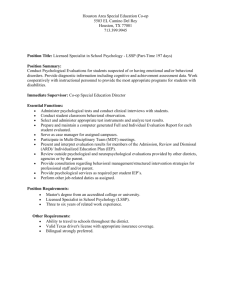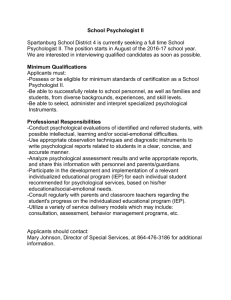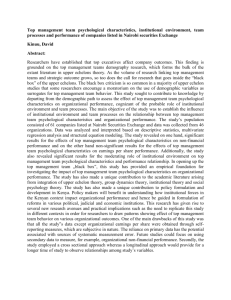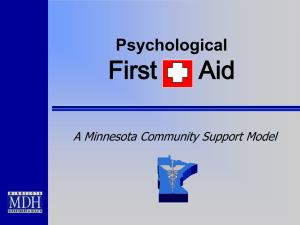Chapter 7: Physical Disorders and Health Psychology
advertisement
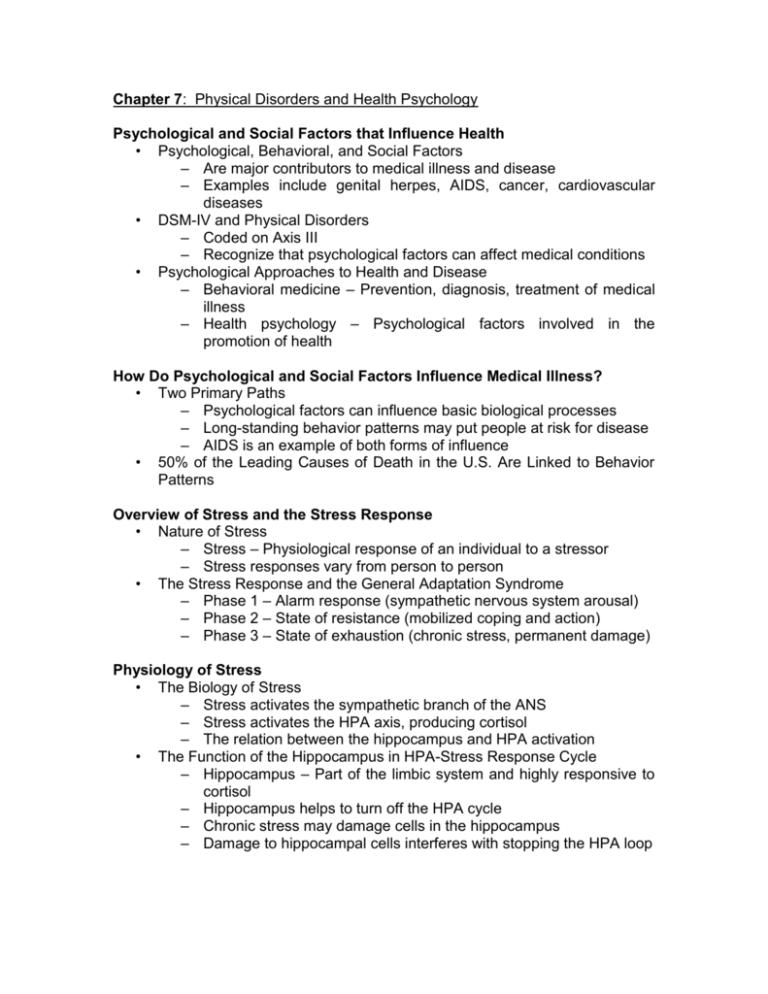
Chapter 7: Physical Disorders and Health Psychology Psychological and Social Factors that Influence Health • Psychological, Behavioral, and Social Factors – Are major contributors to medical illness and disease – Examples include genital herpes, AIDS, cancer, cardiovascular diseases • DSM-IV and Physical Disorders – Coded on Axis III – Recognize that psychological factors can affect medical conditions • Psychological Approaches to Health and Disease – Behavioral medicine – Prevention, diagnosis, treatment of medical illness – Health psychology – Psychological factors involved in the promotion of health How Do Psychological and Social Factors Influence Medical Illness? • Two Primary Paths – Psychological factors can influence basic biological processes – Long-standing behavior patterns may put people at risk for disease – AIDS is an example of both forms of influence • 50% of the Leading Causes of Death in the U.S. Are Linked to Behavior Patterns Overview of Stress and the Stress Response • Nature of Stress – Stress – Physiological response of an individual to a stressor – Stress responses vary from person to person • The Stress Response and the General Adaptation Syndrome – Phase 1 – Alarm response (sympathetic nervous system arousal) – Phase 2 – State of resistance (mobilized coping and action) – Phase 3 – State of exhaustion (chronic stress, permanent damage) Physiology of Stress • The Biology of Stress – Stress activates the sympathetic branch of the ANS – Stress activates the HPA axis, producing cortisol – The relation between the hippocampus and HPA activation • The Function of the Hippocampus in HPA-Stress Response Cycle – Hippocampus – Part of the limbic system and highly responsive to cortisol – Hippocampus helps to turn off the HPA cycle – Chronic stress may damage cells in the hippocampus – Damage to hippocampal cells interferes with stopping the HPA loop Psychological and Social Factors: Their Relation to Stress Physiology • Primate Research: High and Low Social Status – High cortisol is associated with low social status – Low social status is associated with fewer lymphocytes and immune suppression – Dominant males benefit from predictability and controllability • Vulnerabilities Operative in Mental Illness Contribute to Physical Illness – Stress, perceived uncontrollability, low social support, negative affect • Interpretation of Physiological Response and Situation Seems Critical Stress and the Immune System • Divisions of the Immune System – Humoral branch – Blood and other bodily fluids – Cellular branch – Protects against viral and parasitic infections • Function of the Immune System – Identify and eliminate antigens (i.e., foreign materials) from the body – Leukocytes are the primary agents – Macrophages – Body’s first line of defense, surround and destroy antigens, signal lymphocytes – Lymphocytes – B cells (humoral branch) and T cells (cellular branch) – B cells produce antibodies that neutralize antigens – memory B cells that are stored for the next encounter w/the antigens • T cells – Killer T cells directly destroy antigens – Helper T cells (T4) signal B cells to produce antibodies and the other T cells to attack • Can be overactive leading to autoimmune diseases (rheumatoid arthritis) – Suppressor T cells stop production of antibodies when not needed – Memory T cells • Stress Dramatically and Quickly Alters Immune Function Acquired Immunodeficiency Virus (AIDS) • Nature of AIDS – Course from HIV to full blown AIDS is variable – Median time from initial infection to full-blown AIDS is 7.3 to 10 years or more – AIDS is diagnosed when several serious diseases (e.g., pneumonia, cancer, dementia, etc.) appear – Stress of getting an AIDS diagnosis can be devastating • Role of Stress Reduction Programs – Higher stress and low social support speed progression of disease • – Reduce stress of diagnosis, improve immune system functioning AIDS is Influenced by Psychological, Behavioral, and Social Factors Cancer: Psychological and Social Influences • Field of Psychoncology – Study of psychological factors and their relation to cancer • Psychological and Behavioral Contributions to Cancer – Perceived lack of control – Inadequate or inappropriate coping responses (e.g., denial) – Overwhelming stressful life events – Life-style risk behaviors – Psychological factors also are involved in chemotherapy • Cancer is Influenced by Psychological, Behavioral, and Social Factors Cardiovascular Problems: Hypertension • Cardiovascular System: An Overview – Heart, blood vessels, and mechanisms for regulating their function • Hypertension – High Blood Pressure – Major risk factor for stroke, heart disease, and kidney disease – Causes wear and tear of the blood vessels – Essential hypertension is the most common form • Contributing Factors and Associated Features of Hypertension – Affects 20% of all adults between the ages of 25 and 74 – African Americans are most likely to develop hypertension relative to Caucasians – Salt, fluid volume, sympathetic arousal, stress, and lifestyle are contributors – Core psychological contributors include anger and hostility • Hypertension Is Influenced by Psychological, Behavioral, and Social Factors Cardiovascular Diseases: Coronary Heart Disease (CHD) • Coronary Heart Disease (CHD) – Blockage of the arteries supplying blood to the heart muscle – Angina pectoris – Chest pain from partial obstruction of the arteries – Atherosclerosis – Accumulation of artery plaque (i.e., fatty substances) – Ischemia – Deficiency of blood supply because of too much plaque – Myocardial infarction – Heart attack involving death of heart tissue; results when an artery becomes completely clogged w/plaque • Psychological and Behavioral Risk Factors for CHD – Stress, anxiety, anger, poor coping skills, low social support, and lifestyle – Classic Type A Behavior Pattern - excessive competitive drive, sense of being pressed for time, particularly anger and negative affect • CHD Is Influenced by Psychological, Behavioral, and Social Factors Chronic Pain • Acute vs. Chronic Pain – Acute pain – Follows injury and heals within 1 month on average – Chronic pain – Does not decrease with healing and treatment – Severity of pain does not predict one’s reaction to it • Pain: Some Clinical Distinctions – Subjective vs. overt behavioral manifestations of pain • Psychological and Social Factors in Chronic Pain – The role of perceived control over pain and its consequences – Role of negative emotion, poor coping skills, low social support, compensation – Social reinforcement for pain behaviors • Gate Control Theory: An Integrative Account • Endogenous Opiods: Our Body’s Response to Pain – Dorsal horns of spinal column act as a gateway for transmission of pain sensations – Determine pattern and intensity of sensations – Brain sends signals back to the spinal column, influencing this gating mechanism • Endogenous Opiods: Our Body’s Response to Pain – Act like neurotransmitters to inhibit pain Chronic Fatigue Syndrome: Psychological, Behavioral, and Social Influences • Nature of Chronic Fatigue (CF) – Symptoms include lack of energy, marked fatigue, and pain – Most common in females, with incidence increasing in Western countries – No evidence to support link with viral infection, immune problems, depression • Speculation About Causes – CF seems related to a high-achievement oriented lifestyle – Fast paced lifestyle combines with stress and illness – Psychological misinterpretation of after effects of illness • Treatment – Medications are ineffective – Cognitive-behavioral interventions appear promising Psychosocial Treatment of Physical Disorders • Biofeedback: An Overview – Patient learns to control bodily responses – Used with chronic headache and hypertension • Relaxation and Meditation – Progressive muscle relaxation • – Transcendental meditation (TM) Comprehensive Stress Reduction and Pain Management Programs – More effective and durable than individual interventions alone Modifying Behaviors to Promote Health • Life-Style Practices – Many health problems are traceable to lifestyles and behaviors – Behavioral risk factors are also influenced by psychological and social factors – Prevention and intervention programs target behavioral risks to improve health • Types of Life-Style Behaviors – Injury and injury prevention – Repeated warnings are not enough • Injuries are the leading cause of death for people between 1 to 45 years of age – AIDS – Highly preventable by changing lifestyle behavioral factors – China and smoking cessation programs – Getting children involved – Stanford three community study – Success in reducing risk of heart disease; focused on smoking, diet, blood pressure and weight reduction Summary of Physical Disorders and Health Psychology • Psychological Factors Play a Major Role in Physical Disorders – Behavioral medicine and health psychology • Psychological and Social Factors: Their Role in Illness and Disease – Several diseases are influenced by the effects of stress on immune function – Such influences interact with other psychological and social factors • Long-Standing Patterns of Behavior and Life-Style Increase Risk for Physical Illness • Psychosocial Treatments Aim to Prevent or Treat Physical Disorders – Comprehensive individual or community programs are best
